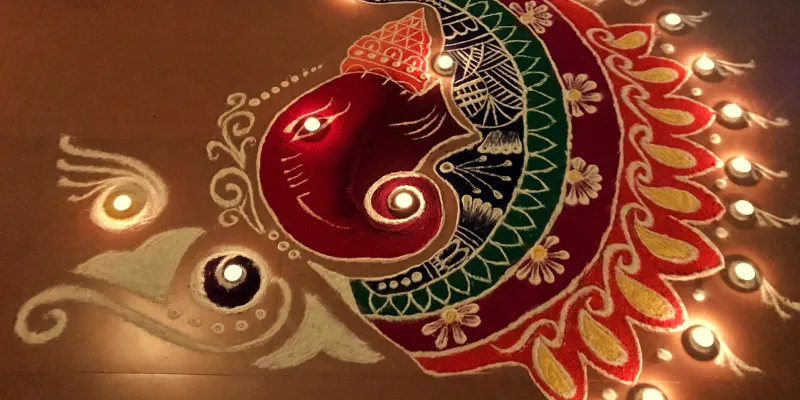How to celebrate an eco-friendly Ganesh Chaturthi
Buying clay Ganesha idols, decorating the pandals with organic colours, and immersing the deity at home, here are a few ways you can go green this Ganesh Chaturthi.
Festivals in India are generally celebrated with all the frills, and the same is true for Ganesh Chaturthi. Right from handpicking flowers and decking up puja rooms and pandals, to making modaks filled with coconut and jaggery, people tend to immerse themselves in a host of activities.
However, often, during the course of the celebration, we don’t realise the extent of harm we might be causing to the environment.
Many of the Ganesha idols that are sold in the market today are made of plastic, thermocol, PoP, and other non-boidegradable materials, which when immersed in water bodies have a detrimental effect on both the plant and animal life.

A clay Ganesha idol set up for puja
Even the rangoli colours available in the market, which are used for decorative purposes, are likely to be made up of hazardous substances like mica, acids, and glass powders. Since these colours cannot be decomposed biologically, they tend to degrade the surrounding spaces.
It might not sound very significant, but even the plastic used to pack or give away the prasad adds to the existing pollution in the environment.
Hence, this time around, let’s look at some ways in which you can celebrate Ganesh Chaturthi with all the pomp and ceremony, but without hurting the planet.

Ganesha idol immersion (Image: Shutterstock)
Clay and mud Ganesha idols
IndiaMART, an ecommerce marketplace, has a variety of options to choose from when it comes to clay and terracotta idols. All you have to do is latch on to their online portal, skim through the options listed on the page, contact the vendor who is selling it, and place an order. The price of the idols ranges anywhere between Rs 100 to Rs 7,000 based on the size.
Amazon and other top ecommerce platforms are also offering eco-friendly handmade idols on their websites.
This year, another option you can consider is that of plantable Ganesha idols. Seed Paper India is the go-to place for this. They are known for their idols embedded with tulsi seeds. So, after celebrating the festival, you can immerse the idol in your backyard, obtain the seed and plant the same.
In case you do not prefer buying idols, you can easily buy a kilogram of clay and make your own figurine at home. Upcycling old products to carve an idol is also a good way to do this. Handmade and eco-friendly idols not only bring in a traditional charm to the festival, but also add a zest of creativity and life.
Go natural and pollution-free
Most often than not, we tend to buy and decorate multiple Ganesha idols at home. While one idol is used to perform a puja with immediate family members, the other is often bought to celebrate with friends or to be placed at pandals. However, limiting the idol to one is something you can definitely consider.
Another environment-friendly measure you can follow is using natural colours for rangoli and other decoration. Items like henna, gulaal, and turmeric might land up giving an earthy feel to the setup as a whole. Even flowers such as magnolias, jasmine, and rose petals can make for beautiful rangoli.

Rangoli made with rice powder (Image: Shutterstock)
While lighting up the puja room or pedestal to enhance the visibility of the Ganesha idol, using an alternative source of lighting might help save energy. LED diyas might serve this purpose just right.
Immersion of ganesha idols in lakes, tanks, and other water bodies is not good for the environment and the marine life. Many a times the idol does not dissolve entirely and leaves several pollutants behind. Hence, symbolic immersion at the comfort of your home is a better option. Any huge bucket or pit can be used for this.
Now, we wish you a safe and green Ganesh Chaturthi!
(Edited by Megha Reddy)




1565700605319.png?fm=png&auto=format&h=100&w=100&crop=entropy&fit=crop)




